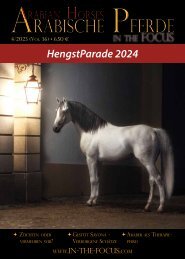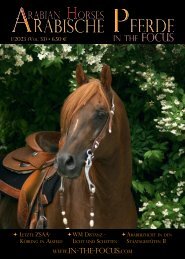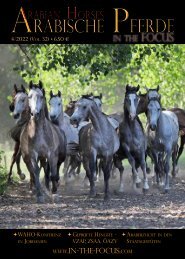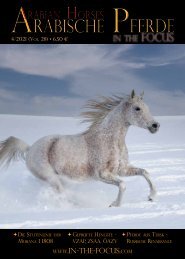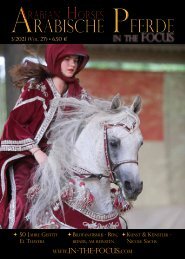Arabische Pferde IN THE FOCUS 2/2021 (Vol. 26) - public
Zeitschrift für Liebhaber und Züchter arabischer Pferde. Haupt- und Landgestüt Marbach - Die neuen Ägypter sind da! Amurath Sahib - Der "Dampfross" unter den Arabern Denkanstöße - Der Schauring und seine Rolle für das Arabische Pferd ZSAA-Körung 2021 - "Yes, we can!" Körung in Pandemiezeiten Helden der Geschichte - Homage an Tibor Pettkó-Szandtner II Von Kunst und Künstlern - Victor Adam und die Pferde aus den Ställen des Königs Distanzreiter-WM - Guter Sport in San Rossore
Zeitschrift für Liebhaber und Züchter arabischer Pferde.
Haupt- und Landgestüt Marbach - Die neuen Ägypter sind da!
Amurath Sahib - Der "Dampfross" unter den Arabern
Denkanstöße - Der Schauring und seine Rolle für das Arabische Pferd
ZSAA-Körung 2021 - "Yes, we can!" Körung in Pandemiezeiten
Helden der Geschichte - Homage an Tibor Pettkó-Szandtner II
Von Kunst und Künstlern - Victor Adam und die Pferde aus den Ställen des Königs
Distanzreiter-WM - Guter Sport in San Rossore
Sie wollen auch ein ePaper? Erhöhen Sie die Reichweite Ihrer Titel.
YUMPU macht aus Druck-PDFs automatisch weboptimierte ePaper, die Google liebt.
(left) Famous Nazeer (Mansour / Bint Samiha)<br />
*1934 was chosen by Tibor Pettkó-Szandtner to<br />
become Chief Sire at El Zahraa and described<br />
him as "among the noblest stallions, he is the<br />
most distinctive."<br />
(links) Der berühmte Nazeer (Mansour<br />
/ Bint Samiha) *1934 wurde von Tibor<br />
Pettkó-Szandtner zum Hauptbeschäler von<br />
El Zahraa bestimmt und er beschrieb ihn<br />
als "unter den edelsten Hengsten, ist er der<br />
markanteste."<br />
(right) Tibor Pettkó-Szandtner and his wife at<br />
El Zahraa.<br />
(rechts) Tibor Pettkó-Szandtner und seine<br />
Frau in El Zahraa.<br />
beide Fotos: Archiv Laszlo Király<br />
Zucht History<br />
Jidran Ibn Sudan, and Sheikh El Arab (Mansour<br />
/ Bint Sabah), a Dahman Shahwan. It is<br />
also to his credit that Tibor Pettkó-Szandtner,<br />
who joined the stud in 1949, could select and<br />
assign many noble mares to his plans.<br />
purpose of breeding being the “preservation<br />
and perpetuation of Arab horse breeding as a<br />
matter of Egypt’s cultural heritage.” It was this<br />
very bloodstock that Tibor Pettkó-Szandtner<br />
was called to reconstruct with his expertise.<br />
The task was clear and evident, just like the<br />
trust and full authority granted to him. His<br />
principals expected that he would introduce<br />
modern principles not only in breeding but<br />
also in husbandry. He received full power and<br />
all the support to do so.<br />
From RAS to EAO<br />
The livestock breeding section of the RAS,<br />
founded in 1898 in order to encourage Egyptian<br />
agriculture, began its operations in<br />
1908. As the state needed a large number<br />
of remounts for the military and police, the<br />
organization “facilitated” horse breeding<br />
in the provinces by outsourcing stallions to<br />
several stallion depots. Initially, these were<br />
English Thoroughbreds, but the attempt did<br />
not work, and the breeders did not like their<br />
offspring. Therefore, the new goal was to supply<br />
the studs with pure-bred Arabian sires.<br />
Here we can see a parallel with the experiment<br />
applied in Bábolna, where, as previous-<br />
2/<strong>2021</strong> - www.in-the-focus.com<br />
However, RAS had a bloodstock, which, according<br />
to the will of the founder Khedive they experimented with and then abandoned<br />
ly mentioned in the first part of the article,<br />
Szandtner<br />
Abbas Hilmi, had been destined for expansion<br />
flourishing over the past decades stallions.<br />
crossbreeding with English Thoroughbred<br />
in harmony with the original purpose, the The basis for the Arab breeding of the national<br />
stud established in Bahteem, near Heliopolis,<br />
was provided by the bloodstock of<br />
Abbas Hilmi, which was donated to the RAS<br />
by the Khedive in 1914 at the time of his dethronement.<br />
The national stud has flourished<br />
over the years with countless donations and<br />
purchases. However, Bahteem was not suitable<br />
for the future plans, the Nile Delta region<br />
was not really suitable for Arabian horses<br />
either, so the RAS moved the breeding operation<br />
to nearby Cairo, to Ein Shams, located<br />
in the desert. The breeding continued here in<br />
the new facility of Kafr Farouk stud, named<br />
by King Fouad after his son. Kafr Farouk’s<br />
first stud manager was Dr. Branch, an English<br />
veterinarian, retired in the mid-1930’s, who,<br />
during his work and as a member of the Jockey<br />
Club at the same time, assigned an important<br />
role to testing the breeding stock on<br />
the racetrack. He was followed by Dr. Ahmed<br />
Mabrouk, an Egyptian veterinarian, who preferred<br />
using “outcross” stallions, then by Dr.<br />
Ashoub. The latter was a devoted advocate<br />
of livestock breeding and was the manager<br />
of the stud between 1941 – 1949. He is also<br />
known for compiling the first Egyptian Stud<br />
Book (1948). His favourite stallions were<br />
Shahloul (Ibn Rabdan / Bint Radia), a Saqlawi<br />
51<br />
European Stable Management<br />
On his arrival, the general had to face significant<br />
challenges: not only the foreign culture,<br />
but also the extreme climatic conditions that<br />
are unusual for Europeans. Not to mention<br />
the language, although his wife’s excellent<br />
knowledge of English must have helped him<br />
here, just like in Bergstetten. The only area he<br />
was not unfamiliar with was breeding Arabian<br />
horses. His primary objective was to improve<br />
the conditions of the stud. As a matter of fact,<br />
Kafr Farouk’s 50-acre area in Ein Shams, apart<br />
from stud buildings, was actually a mere desert.<br />
“We basically do not have any pasture here at<br />
all, only desert sand. From late November to<br />
late May, horses are fed with green clover, which<br />
is dried in the summer, and barley,” he wrote in<br />
his letter to the late German hippologist, Dr. Johannes<br />
E. Flade. Not only was there no grass in<br />
the stud area, but the only shade was provided<br />
by a row of date palms. In an effort to improve<br />
the situation, he immediately commenced<br />
to plant trees. He wanted to create an oasis<br />
around him, a green island in the desert, pleasant<br />
for both humans and animals. Furthermore,<br />
he reformed the procedures of horse feeding,<br />
fodder production and ingathering.



